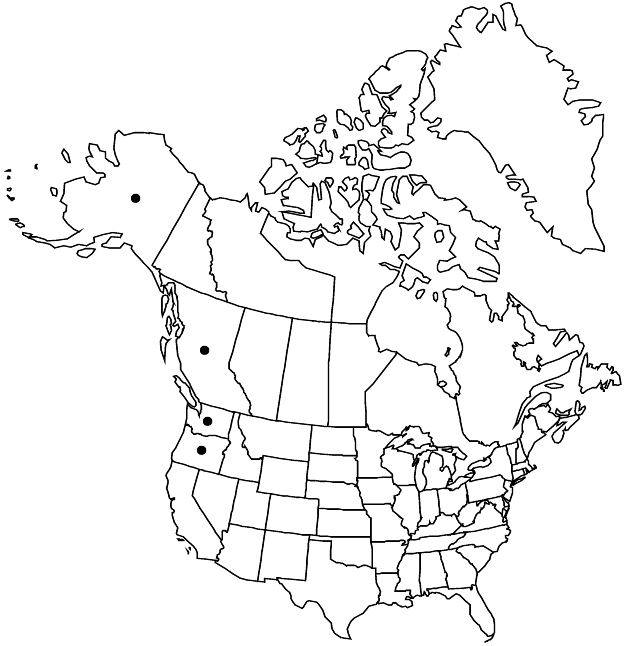Sidalcea hendersonii
Proc. Amer. Acad. Arts 23: 262. 1888.
Herbs, perennial, 0.5–1.5 m, not glaucous, sparsely hairy to nearly glabrous throughout, with woody taproot and short, thick, ascending rootstock, usually also with compact rhizomes to 10 mm diam. Stems usually several, clustered, erect, usually purplish tinted especially near base, mostly unbranched, sometimes proximally hollow, base glabrous or sparsely hairy, hairs minute, simple or stellate, more densely scabrous distally. Leaves basal and cauline, ± fleshy; stipules deciduous, often purplish, lanceolate to linear, 6–11 × 1–3 mm; petiole often purplish tinted, those of basal leaves to 30 cm, proximalmost 3 times as long as blades, mid cauline 1–2 times as long as blades, distalmost to 1/2 times as long as blades and leaves subsessile; basal blades orbiculate, unlobed or shallowly 5-lobed, 7–15 × 7–15 cm, margins crenate or dentate, ciliate, surfaces glabrous or sparsely hirsute, hairs sometimes forked, not stellate, mid cauline palmately 7–9-lobed, incised 1/2+ length, 7–12(–17) × 7–12(–17) cm, lobes cuneate, margins coarsely dentate to pinnatifid, apex toothed, surfaces: adaxial sparsely hairy or only on veins, ciliate, distal cauline leaves 3–5-parted nearly to base, lobes narrowly lanceolate to linear, margins coarsely dentate-laciniate. Inflorescences erect, spiciform, dense, especially when young, sometimes elongate, calyces usually conspicuously overlapping in flower and sometimes in fruit, usually branched, 20-flowered, usually several to many open at same time, not 1-sided, 5–20 cm; bracts purplish, lanceolate to linear, undivided, rarely 2-fid, 4–5 mm, longer than pedicels, shorter than calyx. Pedicels 1–4 mm, to 7–8 mm in fruit; involucellar bractlets absent. Flowers bisexual or often unisexual and pistillate, plants gynodioecious; calyx somewhat urceolate, 8–9 mm, to 10–12 mm in fruit, lobes strongly reticulate-veined, sparsely stellate-hairy or proximally glabrous, lobe tips usually purple, rarely green, margins ciliate; petals bright pinkish lavender, drying deep purple, veins not paler, bases not white, pistillate usually 8–10 mm, bisexual (10–)15–20 mm; staminal column 6–7 mm, hairy; anthers white; stigmas (5–)7 or 8(or 9). Schizocarps 8–9 mm diam.; mericarps (5–)7 or 8(or 9), 4 mm, smooth, glabrous (rarely sparsely glandular-puberulent), thin-walled, apical margins sharp-edged, not winged, back sometimes slightly wrinkled, mucro 0.8–1.3 mm. Seeds 3 mm. 2n = 20.
Phenology: Flowering Jun–Aug.
Habitat: Coastal marshes, sandy to boggy tidal areas, upper beach meadows
Elevation: 0–50 m
Distribution

B.C., Alaska, Oreg., Wash.
Discussion
Sidalcea hendersonii is showy and distinctive; it has been confused with S. oregana subsp. spicata and with S. cusickii, to which it is similar and apparently closely related. Like S. cusickii, S. hendersonii generally has purplish tinted vegetative parts, compact inflorescences with flowers that are mostly open at the same time, and ciliate calyx lobes. Sidalcea hendersonii is generally considered vulnerable; the number of extant populations has declined in recent decades, especially in Oregon, where it is close to extirpation. It can be distinguished by its marshy seacoast habitat, its often hollow stems, its tendency to be glabrous, its dense, compound inflorescences, and its relatively large mericarps and mucro. It is the northernmost species of Sidalcea and is the one better adapted to brackish or saline marshes. Sidalcea hendersonii occurs from Douglas County, Oregon, to British Columbia, and a single specimen is known from Alaska.
Selected References
None.